(Press-News.org) Obsessive-compulsive disorder (OCD) in children and adolescents is associated with impaired education and worse general health later in life. Access to specialist treatment is often limited. According to a study from Centre for Psychiatry Research at Karolinska Institutet in Sweden and Region Stockholm, internet-delivered cognitive behavioural therapy (CBT) can be as effective as conventional CBT. The study, published in the prestigious journal JAMA, can help make treatment for OCD more widely accessible.
Obsessive-compulsive disorder (OCD) is a potentially serious mental disorder that normally debuts in childhood.
Symptoms include intrusive thoughts that trigger anxiety (obsessions), and associated repetitive behaviours (compulsions), which are distressing and time consuming.
Early diagnosis and treatment are essential to minimise the long-term medical and socioeconomic consequences of the disorder, including suicide risk.
The psychological treatment of OCD requires highly trained therapists and access to this kind of competence is currently limited to a handful of specialist centres across Sweden.
Earlier research has shown that while CBT helps a majority of young people who receive it, several years can pass between the onset of symptoms and receipt of treatment.
Researchers at Karolinska Institutet have spent three years evaluating whether low-intensity internet-delivered CBT for children and adolescents with OCD can be used in a stepped care model in order to improve access to treatment without compromising its efficacy.
The two-centre study was conducted in collaboration with Child and Adolescent Mental Health Services in the Stockholm and Vastra Gotaland regions and comprised 152 participants between the ages of eight and 17.
The participants were randomly assigned to one of two groups. One group first received therapist-guided digital CBT, and the other (control) received standard CBT through weekly in-person sessions with a therapist.
Each group received treatment for a period of 16 weeks, supported by their therapists and parents.
The researchers then followed up the participants three months after treatment in order to evaluate the therapeutic effect on OCD symptoms, daily function and depressive symptoms.
After the 3-month follow-up, the participants in both groups deemed in need of additional support received up to 12 extra sessions of conventional CBT up until the 6-month follow-up.
The results showed that stepped digital CBT reduced the participants' OCD symptoms as much as conventional CBT. Approximately 70 per cent of participants in both groups were treatment responders at the 6-month follow-up.
"The advantage of the stepped care approach is that it makes it easier for us to reach out to more children and adolescents with OCD in need of help," says the study's first author Kristina Aspvall, psychologist and researcher at the Centre for Psychiatry Research, part of Karolinska Institutet's Department of Clinical Neuroscience.
Crucially, the stepped care group required fewer resources: therapists spent an average of 9 hours per participant in the stepped treatment group and 14 hours per participant in the control group.
"The study demonstrates the potential of technology when it comes to increasing access to evidence-based therapy for young people with OCD," says principal investigator Eva Serlachius, adjunct professor at Karolinska Institutet's Centre for Psychiatry Research. "By offering low-intensity digital intervention as the first step of treatment, clinics can save precious resources and devote their limited time to treating more patients or focusing on more complex cases."
Internet CBT for OCD is currently being implemented in regular care through Region Stockholm's Child and Adolescent Mental Health Services (BUP Internetbehandling), which also collaborates with other health authorities across Sweden. The treatment was developed by researchers at Karolinska Institutet and Region Stockholm.
INFORMATION:
The study was financed by FORTE (the Swedish Research Council for Health, Working Life and Welfare), ALF Medicin, the Jane and Dan Olsson Foundation, the Queen Silvia Jubilee Fund, the Swedish Mental Health Fund and the Fredrik and Ingrid Thuring Foundation.
Publication: "Effect of an internet-delivered program vs in-person cognitive behavioral therapy on obsessive-compulsive disorder symptoms in children and adolescents: a randomized clinical trial", Kristina Aspvall; Erik Andersson, Karin Melin, Lisa Norlin, Viktor Eriksson, Sarah Vigerland, Maral Jolstedt, Maria Silverberg-Morse, Lena Wallin, Filipa Sampaio, Inna Feldman, Matteo Bottai, Fabian Lenhard, David Mataix-Cols, Eva Serlachius. JAMA, online 11 May 2021, doi: 10.1001/jama.2021.3839.
Toxicity and Challenges in Transferability of Surface-functionalized Metallic Nanoparticles
https://doi.org/10.15212/bioi-2020-0047
Announcing a new article publication for BIO Integration journal. In this review the authors Muhammad Arif Asghar, Rabia Ismail Yousuf, Muhammad Harris Shoaib, Muhammad Arif Asghar and Nazish Mumtaz from Jinnah Sindh Medical University, Karachi, Pakistan, University of Karachi, Karachi, Pakistan, Food and Marine Resources Research Centre, Pakistan and Benazir Bhutto Shaheed University, Karachi, Pakistan discuss toxicity and challenges in transferability of surface-functionalized metallic nanoparticles from animal models to humans.
The unique size and surface morphology of nanoparticles ...
A new drug combination that is better at treating miscarriage is also more cost effective than current standard NHS treatment, finds a new study led by the University of Birmingham and Tommy's National Centre for Miscarriage Research.
A previous study by the same team and published in The Lancet * in August last year, found that a combined drug treatment is more effective than the standard medication for women having miscarriages without symptoms - also known as missed, delayed or silent miscarriage.
Missed miscarriage occurs when a baby has died in the womb but the mother hasn't ...
A study by the University of Southampton has shown its LifeLab programme, aimed at improving adolescent health through hands-on learning, significantly increases young people's understanding of what it means to lead a healthy lifestyle.
Led by a team from both the Faculty of Medicine and Education School at the University of Southampton, the LifeLab programme aims to encourage engagement with the science behind public health messages, to support development of health literacy alongside decision-making skills and promotion of adolescents' sense of control over their lives and futures. Based at University Hospital Southampton (UHS) NHS Foundation Trust, LifeLab is a state-of-the-art teaching laboratory ...
The COVID-19 pandemic has now claimed over 2 million deaths worldwide, and this number is only increasing. In response, health agencies have rolled out tests to diagnose and understand the disease. Besides the now widely known PCR test, there is interest in serological (blood) tests that detect "antibodies" against SARS-CoV-2, the virus that causes COVID-19. These blood tests have considerable applications, from identifying blood donors with high levels of anti-SARS-CoV-2 antibodies, whose blood can be used for convalescent plasma therapy, to measuring vaccine effectiveness.
So, what are antibodies? These are proteins produced by the ...
This rare fossil find comes from the Kimmeridge Clay Formation in England, a series of sedimentary rocks that was formed in a shallow, tropical-subtropical sea during the Upper Jurassic, about 150 million years ago. The fossil shark skeleton was found more than 20 years ago on the southern coast of England and is now held in the Etches Collection. Additional fossil shark specimens from it will be investigated in the years to come.
Due to their life-long tooth replacement shark teeth are among the most common vertebrate finds encountered in the fossil record. The low preservation potential of their poorly mineralized cartilaginous skeletons, on the ...
A scientist from HSE University has developed an image recognition algorithm that works 40% faster than analogues. It can speed up real-time processing of video-based image recognition systems. The results of the study have been published in the journal Information Sciences.
Convolutional neural networks (CNNs), which include a sequence of convolutional layers, are widely used in computer vision. Each layer in a network has an input and an output. The digital description of the image goes to the input of the first layer and is converted into a different set of numbers at the output. The result goes to the input of ...
Wastewater testing is an effective way to identify new cases of COVID-19 in nursing homes and other congregate living settings, and it may be particularly useful for preventing outbreaks in college dormitories, a new University of Virginia study finds.
The research, a collaboration of UVA's School of Medicine and School of Engineering, was led by UVA Health's Amy Mathers, MD. It offers some of the first clear guidance on the most effective methods to perform testing to detect COVID-19 in wastewater.
The researchers evaluated and compared sampling and analysis techniques by testing them within buildings with known numbers of positive cases. They were then able to determine wastewater testing's strengths and limitations as a tool for monitoring COVID-19 in a building population. ...
SASKATOON - Tepary beans--a high protein legume common to the southwest United States and Mexico--may hold the key to adapting bean crops for the increasingly harsh conditions brought on by a changing climate, according to research led by University of Saskatchewan (USask) and Michigan State University.
In a study just published in Nature Communications, the researchers found that as the mercury rises to 27oC at night--a temperature devastating for current bean crops--specific genes sensitive to heat stress in the tepary bean get activated, protecting the plant. ...
The investigators used machine learning to predict which patients might get worse and not respond positively to being turned onto their front in intensive care units (ICUs) - a technique known as proning that is commonly used in this setting to improve oxygenation of the lungs.
While the AI model was used on a retrospective cohort of patient data collected during the pandemic's first wave, the study demonstrates the ability of AI methods to predict patient outcomes using routine clinical information used by ICU medics.
The researchers say the approach, where each patient's ...
Alexandria, Va., USA -- Carbon dioxide (CO2) is a byproduct of human metabolism and exists in high levels in exhaled air, and is therefore often used as a proxy for indoor air quality. The study "Ventilation Assessment by Carbon Dioxide Levels in Dental Treatment Rooms," published in the Journal of Dental Research (JDR), evaluated CO2 levels in dental operatories and determined the accuracy of using CO2 levels to assess ventilation rate in dental clinics.
Researchers at the University of Rochester, Eastman Institute for Oral Health, N.Y., USA, conducted CO2 concentration and ventilation rate assessments in 10 closed dental treatment rooms with varying ...





